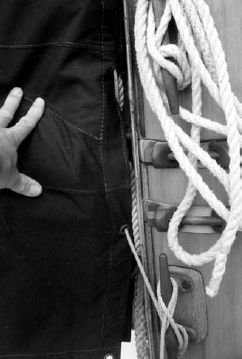
Being able to get the sail cover on quickly means we don’t have to resent the time it takes to protect our sails. Just as important, if a halyard starts slapping the mast just when we are starting to doze off, we hate having to open up the sail cover to get at the halyard or cleat to tighten it. Thus, we had our recent sail covers made so the cover stops behind the mast instead of going around it to fasten at the front. Instead of snaps or hooks, we use a simple lacing that we secure with a cleat.
As the object of a sail cover is to keep as much sun off the sail fabric as possible, we get the cover maker to keep any holes for lazy-jacks as small as possible. We have seen flaps secured in place using Velcro. While this seems like a good idea, the Velcro tends to load up with dirt and stray threads, and it doesn’t always align well. After two or three years, the flaps don’t stay closed properly. The twist-lock fasteners have worked perfectly for five years.
We store Taleisin’s working jib on the bowsprit except when we are at sea in rough weather. The sail cover not only protects the sail, but by adding a small nose cone on a piece of shock cord, we protect the entire bowsprit. Since we added this nose protector, we have doubled the life of our varnish.
This and other useful cruising tips are on Lin and Larry’s new website. Go to: landlpardey.com.




